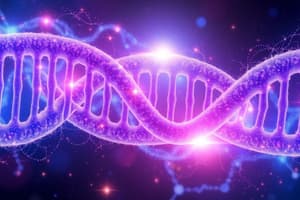Podcast
Questions and Answers
What is the main outcome of the process involving matching codons in mRNA to tRNA molecules?
What is the main outcome of the process involving matching codons in mRNA to tRNA molecules?
- Formation of mRNA strands
- Formation of a polypeptide chain (correct)
- Replication of DNA
- Activation of a gene
What are the elements that work together to control gene expression by influencing gene regulation?
What are the elements that work together to control gene expression by influencing gene regulation?
- Ribosomes, tRNA, rRNA, and mRNA
- Amino acids, proteins, lipids, and carbohydrates
- Promoter regions, enhancers, silencers, and transcription factors (correct)
- Chromosomes, DNA polymerase, helicase, and ligase
What is the starting point on chromosomes where the process of replication begins?
What is the starting point on chromosomes where the process of replication begins?
- Enhancer sequence
- Origin of replication (correct)
- Silencer element
- Promoter region
During replication, what serves as a template for the synthesis of a new complementary strand?
During replication, what serves as a template for the synthesis of a new complementary strand?
What is the role of transcription factors in gene regulation?
What is the role of transcription factors in gene regulation?
How are all the necessary amino acids assembled in the process that leads to the formation of a polypeptide chain?
How are all the necessary amino acids assembled in the process that leads to the formation of a polypeptide chain?
What is the primary function of transcription?
What is the primary function of transcription?
Which of the following statements about the DNA double helix structure is correct?
Which of the following statements about the DNA double helix structure is correct?
Which of the following is not a nitrogenous base found in DNA?
Which of the following is not a nitrogenous base found in DNA?
What is the primary role of mRNA in the process of translation?
What is the primary role of mRNA in the process of translation?
Which process is responsible for the expression of genetic information into functional proteins?
Which process is responsible for the expression of genetic information into functional proteins?
What is the primary function of gene regulation?
What is the primary function of gene regulation?
Flashcards are hidden until you start studying
Study Notes
Molecular Biology: Exploring DNA Structure, Translation, Gene Regulation, Transcription, and Replication
Molecular biology is a branch of biology that focuses on the molecular components of living organisms, including genes, proteins, and DNA interactions. It encompasses various interconnected aspects such as the structure of DNA, gene regulation, transcription, translation, and replication. These subtopics are crucial in understanding how genetic information is stored, transcribed, translated, and expressed in cells.
DNA Structure
The double helix structure of DNA consists of two complementary strands twisted together. Each strand is composed of nucleotides connected by phosphodiester bonds. DNA contains four nitrogenous bases: adenine (A), cytosine (C), guanine (G), and thymine (T). The base pairs form properly paired Watson-Crick structures (A-T, G-C), ensuring proper coding and replication.
Transcription
Transcription is the process by which genetic information encoded in DNA is copied into RNA. This process occurs in the nucleus of eukaryotic cells and in both the cytoplasm and nucleus of prokaryotic cells. The resulting RNA molecules, called mRNA, can leave the cell and travel to the ribosome where they are translated into proteins.
Translation
Translation is the process by which the cell uses the genetic information contained in the mRNA to create specific proteins. This process involves matching the codons in the mRNA to the corresponding transfer RNA (tRNA) molecules and amino acids. Once all the necessary amino acids are assembled, they form a polypeptide chain, which eventually becomes a functional protein.
Gene Regulation
Gene regulation refers to the processes by which the expression of a gene is controlled. This includes both activation and repression of gene expression. Several factors influence gene regulation, including promoter regions, enhancers, silencers, and regulatory proteins known as transcription factors. These elements work together to control when and how much of a particular gene product is produced.
Replication
Replication is the process by which a cell copies its entire genome before cell division. In most organisms, replication starts at a specific point on the chromosomes, called the origin of replication. As the replication machinery moves along the chromosome, it unwinds the double helix and separates the complementary strands. Each strand then serves as a template for the synthesis of a new complementary strand. After replication, the chromosomes return to their original shape, and the cell prepares for cell division.
Understanding these fundamental concepts in molecular biology is essential for advancing our knowledge in areas like genetic engineering, medical treatments, and environmental applications. As technology advances, we will continue to uncover new insights into the intricate world of molecules and their roles in life processes.
Studying That Suits You
Use AI to generate personalized quizzes and flashcards to suit your learning preferences.




